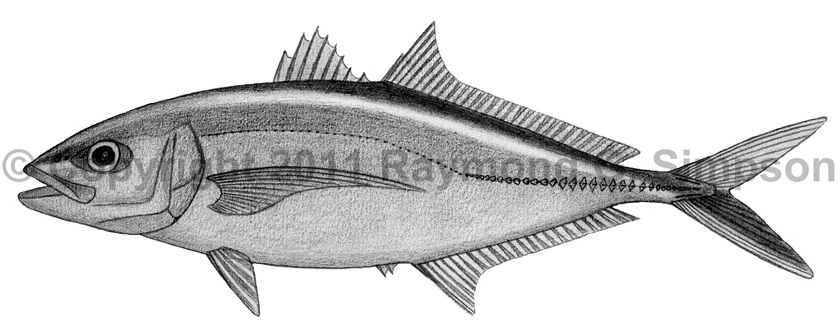
Common Name
Bar Jack
Year Described
Bloch, 1793
Identification
Dorsal Fin: 8 spines in first lobe, followed by I, 26-30
Anal Fin: 2 spines separate from rest, followed by I, 23-26
Pelvic Fin: I, 5
Gill Rakers: 10-14 upper, 31-38 lower
Vertebrae: 10 precaudal, 14 caudal
Elongate, moderately compressed, and moderately deep-bodied, with a large head, pointed snout, and a moderate eye (5.4-5.8 times in HL). Adipose eyelid moderate. Snout long; jaw at most barely reaching anterior margin of eye. Teeth villiform; in a single band in both jaws (widest anteriorly). Pectoral fins falcate, longer than head. Spiny dorsal fin lower than lobe of second dorsal fin. Anterior lobe of second dorsal and anal fin raised. Tail deeply forked. Lateral line with a moderate anterior arch and a straight posterior portion with 23-29 scutes. Small cycloid scales on entire body, including entire chest. Bilateral caudal keels present. Hyperostosis absent.
Color
Silvery on body, with a blue-gray tint above. A dark stripe extends over the entire dorsal midline from snout to the caudal fin, continuing onto the lower caudal fin lobe. A blue band of similar width borders underneath the black stripe. Dorsal and anal fins body colored or dusky (rear dorsal often dark). Upper caudal and dorsal lobe often with a yellowish tip. Juveniles with 6 dark bands.
Size
Common to 40cm FL. Maximum size to >50cm FL.
Habitat
Insular pelagic or reef associated in clear waters. Found in small to large schools. Juveniles associate with flotsam.
Range
New Jersey to Venezuela, including Bermuda and the Caribbean islands.
References
Smith-Vaniz, W.F. 2003. Carangidae (pp 1426-1468). In: Carpenter. 2003. The living marine resources of the Western Central Atlantic v. 3.